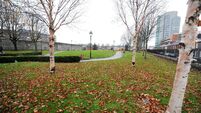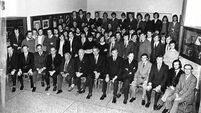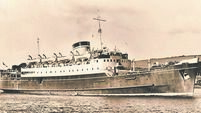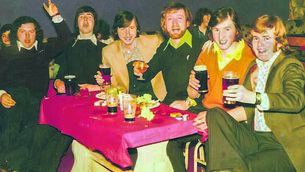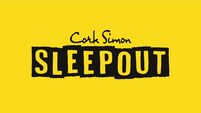My broken leg agony playing rugby at Pres... they carried me off on potato sacks!
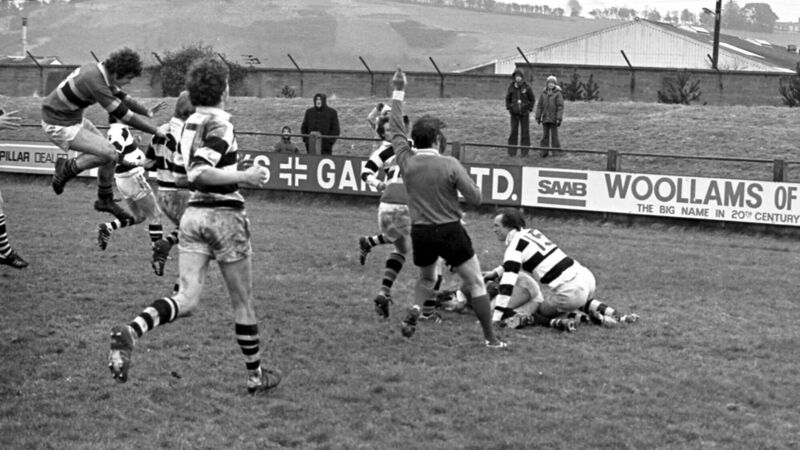
Action from the Colleges Munster Cup Final between Christians and Pres at Musgrave Park, Cork, on March 17, 1979, as Bernard Moylan scores Christians’ first try despite the tackle of Pres’ Brendan Lucey
RUGBY is on everyone’s mind this coming weekend - will we win the Grand Slam against England or not? And the excitement brought back a vivid memory to that renowned photographer with the Echo and Examiner (now contentedly retired), Des Barry.
“When you see the care they take of injured players these days, it reminds me of a long-ago match when I was 14,” reminisces Des.
“I was at Pres, and we were playing Christians out on the Mardyke. These were big occasions, since everybody in Cork supported either one or the other of the two big schools, and there were always crowds there to cheer on their teams.
"Well, it was a fairly rough game, as rugby tends to be, and what should happen but that I got my leg broken. No mobile stretchers on wheels back then - they got a couple of empty potato sacks and carried me off the field in those.
“Now, my father was very big into rugby and used to coach the teams all the time. He happened to be coming in the gates as I was being carried out. ‘What happened to you?’ he asked, barely pausing as he went by. ‘My leg is broken, they’re taking me to the hospital,’ I replied from my sack of pain. ‘I’ll be down to see you later,’ he responded, heading in the direction of the dressing rooms. And that was all the sympathy I got from him!”
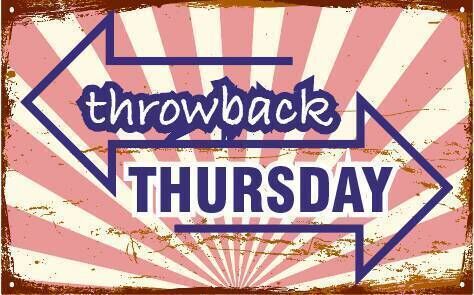
Out on to the Mardyke they carried our hero, where a Cash’s van was flagged down to help in the rescue. No ambulances for injured schoolboys back then, recalls Des wryly.
Off down Western Road, in along Washington Street, and a sharp right over Parliament Bridge, a particularly sharp hump-back.
“The jolt the van gave sent me flying, and the bone stuck out of my leg!” recalls Des.
He was taken to the South Infirmary where he spent a full year, if you can believe it. These days they have you out almost before you’ve got in.
“I had a grand time, though,” he says. “I was in the male ward, because there was no room in the children’s one, and I got spoiled rotten.
“The fellow in the next bed was a pal of the hospital chef, so when the others were getting cheese or tomato sandwiches, he got chicken, and shared it with me!”
Going back to school was no fun, though, Des says, as he had got very behind in his studies, and had to struggle to keep up.
“Never lost my passion for rugby, though - spent all my years as a press photographer covering every match I could!”
Des is now planning every minute of next Saturday, so as to make the most of the big decider against England.
“We’ve the best team in the world at the moment, so we should do it all right, get the Grand Slam. And we deserve it!”
And now to timepieces, aka clocks and watches, another topical subject since the venerable Mangan’s Clock on Patrick Street has recently been repaired and is back in working order.
How many generations made arrangements to meet “at three o’clock under Mangan’s clock”? These were usually between school pals, as trysts of the romantic kind were always arranged for “de steps of de Savoy”, where, on a Saturday evening, you could always see at least one embarrassed youth or anxious girl trying not to look as though they were waiting for someone.
What was the Cork term for being stood up? Oh yes, “getting a fifty”. Wonder what that came from?

Tim Cagney has had a long affection for clocks and watches.
“Since early childhood, these have held a strong fascination for me,” he says.
“Every Sunday, my father used to buy both the Sunday Press and Sunday Independent. On the back-page of one of them there would be advertisements by a certain jeweller in Dublin, displaying images of watches, along with details of their construction and - of course - price. What we might now take for granted, like ‘waterproof, dustproof, shockproof,’ were all carefully listed as plus points back then. Most of the casings were made of what was described as ‘rolled-gold’, and featured accessories like ‘expandable bracelets.’
“What really intrigued me was the reference to ‘jewels,’” adds Tim. “The number of jewels varied, from perhaps, 12 to 24, depending on the cost of the timepiece. The average seemed to be 17. What were these, and what function did they serve?
“They were, in fact, tiny chips of ruby, on which the spindles of the cog-wheels would pivot. This helped minimize friction and - of course - metal fatigue.
“The prices themselves were never exorbitant - they seemed to average out at around £3.10s. I dreamed of owning one myself, but hadn’t a penny to my name.”
One day, however, his luck changed.
“My father presented me with a rectangular black box. ‘That,’ he said, ‘is from Uncle Mick - be sure to write and thank him’. Inside was a gold-rimmed watch, with a black dial and luminous hands. It was on a black leather strap.
“Uncle Mick was my father’s eldest brother, Michael Cagney. He never married, and lived his entire life at the parental home on Cattle Market Street (present-day Glen Ryan Road). He worked in the factory of Edward Ryan & Co., Pope’s Quay, where they made soap and candles. On at least two occasions, in my lifetime, he was scalded by boiling fat.
“Every Sunday, he attended Mass at nearby St Mary’s. After Mass, he would stand in the portico of the church, watching the world go by.
Tim adds: “My father ran a book stall in the grounds, selling publications such as The Universe, The Catholic Herald and The Sunday Messenger. My younger brother, Con, used to ‘help’. We would always run around to see Uncle Mick, who never failed to cross our palms with silver - usually a two-shilling piece, or a half-crown on a good day.
“As I said, he never married, so I suppose he looked on Con and myself as his own.”
The watch, says Tim, arrived when he was in his early teens.
“On the very day I got it, I composed a carefully-worded letter of thanks to Uncle Mick, and dispatched it to Cattle Market Street.
"I wore the watch proudly, for many years, until the mainspring broke, as they invariably did, in those days. By then, of course, I was a ‘working man’ and well able to buy a replacement.”
Tim’s preoccupation with watches, though, has never waned.
“Today, I have a collection of around six or seven. Some have well-known names, such as Rado and Tag Heuer. The one which attracts most attention, however, is a piece I discovered in Sorrento, less than 10 years ago. The name on the movement is one I’ve never heard of - most likely Japanese - but the case and wrist-band are made of olive-wood. The ticket-price was €85. When I proffered the credit-card, the shop-owner said ‘€50 - cash.’ Deal done!
Thanks for sharing that memory, Tim!
Now, do you remember those mysterious city tunnels which we talked about last week in Throwback Thursday? (If not you can catch up on it in the link below) And the one my brother had actually seen, leading from the back of the former Christians under Wellington Road? Well, we heard from Jason O’Mahony on this one.

“Hi, cool article re the tunnels around Cork. Regarding the tunnel from Christians, that site across the road on Sidney Hill was originally Government House, the seat of British power in the city. It was burned down in 1922, but survived until the ’60s, when it was demolished. It was a beautiful building though. Maybe the tunnels were a security measure for the important people that worked in Government house to escape…?
Jason has thoughtfully supplied us with a picture of that former establishment, which was indeed a spectacular building.
Tunnels always excite interest, especially if they are secret or forgotten. Ger Coughlan sent us an extract from that classic old work, Directory And Picture Of Cork And Its Environs, by Will West, which was in all probability published by Guys of Patrick Street. In this book, Ger points out, Mr West mentions a network of caves and tunnels running from Ovens right in as far as Gillabbey and wonders if we knew of them.
Well, this writer can certainly reassure you there, Ger. My siblings and I were dragged into and along those Ovens caves from the earliest possible age by our father, the intrepid Joey, who liked nothing better than bumping his head on encroaching limestone roofs, unless it was diving into a bottomless pool of water in the dark, in the calm belief that there would be air on the other side of the rock face which blocked our way. (Yes, he did, and yes, fortunately there was!).

So well did he know these caves (he had been exploring them since the ’20s), that when the Civil Defence held a rescue exercise there some time in the ’80s, Papa went down with them to show where the narrow passages were that could be traversed, and where the dead ends were that couldn’t. The organising officials were a bit worried about an elderly gentleman undertaking such a strenuous and risky project, but it was all in a day’s (or night’s) work for him.
There were plenty of legends about those caves, extending all the way to the city, but although we certainly have limestone all the way along, the caves themselves peter out fairly soon at Ovens.
Donal Clifford has written to say that he has always heard of many tunnels in Cobh, leading down from the heights to the sea, especially around the Holy Ground area. He recommends talking to Jonny Hennessy, who is an expert on this town’s local history, and we will certainly do that.
It does inspire ideas and visions of pirate treasure and the sound of sea-boots stamping on stones as barrels and bales are furtively carried up from the quays in the dead of night, to be safely stored in houses above the town, doesn’t it? Hopefully there will be more on this soon - Jonny Hennessy, are you listening?
And finally, do you remember that picture supplied by Martin Byrne that we printed a few weeks back, showing what was probably the opening of the new City Hall in the 1930s, and asking you to identify anyone in the photo?
Malcolm has written to say: “May I suggest that the person on the front row extreme right, may be General Tom Barry? It very much looks like him, I knew him in the late ’60s.”
Good man, Malcolm. Any more identifications out there? If you can put a name to another face in that picture, or indeed have any other memories to share, don’t delay.
Email jokerrigan1@gmail.com or leave a comment on our Facebook page: https://www.facebook.com/echolivecork.
